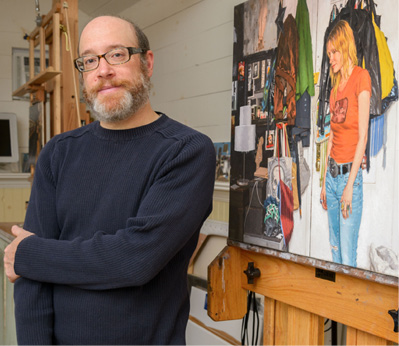January 1, 2016
Finding beauty and truth in the people and places he encounters, local artist Vincent Giarrano creates magnificent realistic paintings from modern life.
Vincent Giarrano doesn’t want to paint a bowl of fruit. “I like capturing fleeting moments in real life.” He mostly loves painting figures, and he tends to gravitate towards women as a subject— the clothing is particularly appealing to him. Interiors and architectural details can also be found in his work. “The historical architecture in New York City is full of character. You feel it there.” He discovered urban landscapes early on when he was trying to figure out what he wanted to paint. (It’s not surprising that he likes Edward Hopper’s work.) He wanted to capture that edge—life in the city.
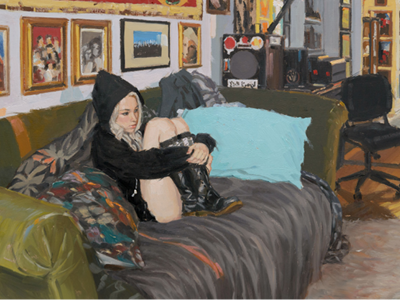
If you’re in Manhattan, you may come across Giarrano in a narrow lane in Soho, using a customized cigar box (called a pochade) while he concentrates on the facade of a building with an archway for a small study to be used later in a painting. Pochade boxes are compact boxes that allow the artist to keep all of their supplies in one location and work on the inside of the lid. These boxes are traditionally used for plein air painting and for travel, the maximum size canvas or work surface is quite small, usually not over 12 inches. Vincent tries to go into the city to paint at least once or twice a month. He also does plein air painting here in Litchfield county, but his landscapes tend to have more resolve than a typical landscape painting. Even his still life pictures have “life”.
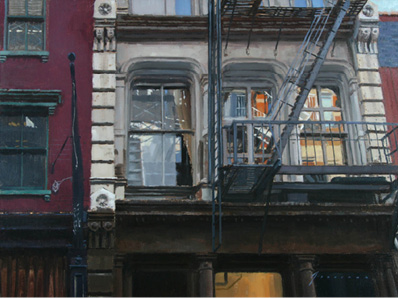
Vincent prefers oil to any other medium. “Oil is king. It’s what people want. Oil paint is very forgiving. It captures reality more than watercolor.” Originally, he started off with a very limited palette but, now and then, he adds other colors. He usually begins with a warm ground. Then he draws with the same mixture directly over the ground. Sometimes he doesn’t draw, he just paints. “The whole process is about change and loss. You can’t be possessive about what you have. You have to let it go,” Vincent says, “you can’t improve if you hold on, you have to not care so much, it will inhibit you, you will not learn new things and evolve. I learned that early on.”

Learning how to turn off your brain and use your eyes is super important, according to Giarrano. He notes that observational information is supportive instead of leading. In illustration it is the opposite. “When I am painting, I am focused on shapes of paint, shapes of color. If you look at one of Sargent’s paintings up close, it’s a mess.” Indeed, when you step back to look at Giarrano’s paintings, they look very tight, very realistic with a lot of detail, but as you get closer you realize that it is actually quite loose, almost impressionistic. There is an emotionally charged quality to the brush strokes. Somehow he is able to capture the details and tell the bigger story with color and light; his compositions calm, but full of expression.
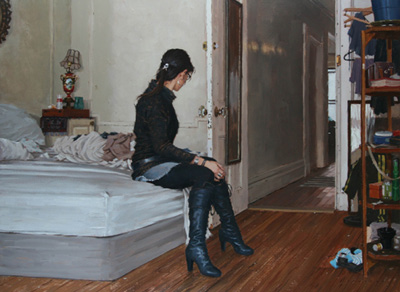
Giarrano doesn’t usually paint on large-sized canvases, but it depends on the subject matter. Scale is a huge part of figuring out what works best for a subject. Before he begins a new painting, he either works from a posed figure or uses photographs that he sets up. He also does drawings and small studies, before beginning a painting. Whether he is in his studio or at a subject’s place, he spends time early on exploring the composition. “I’m editing and changing things as I go.” The average time that Vincent spends on a painting is about 4 weeks, sometimes more; on a smaller scale, he has done studies in 2 hours.

The journey of how this talented artist ended up living in the Northwest Corner is typical of other artists and creative folks who have settled here. Vincent and his wife Kathy, a creative director, were living in Fairfield because it was not far from New York City. Both were going into the city for work. But once they began freelancing from home, it was no longer necessary to be close to the city. Fairfield was becoming very congested, and they had just had their first child and were beginning to think about schools. They decided to look for something more rural. They looked at homes for sale in Vermont, New Hampshire, and the Hudson Valley. In their search, they came across Washington, Connecticut and were taken by its beauty, great culture, the restaurants, and the educated, intelligent people in the community. They found that there were many artists and art lovers in the area. So they bought a circa 1910 Colonial home and settled in Washington, raising their two children here. They converted the former chicken coop into a studio where they both have their work spaces.
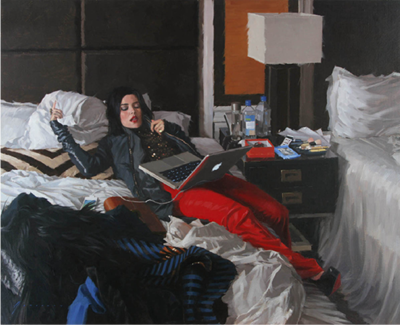
Vincent remembers that as a young child, his mother used to draw him little pictures. Although no one in his family was an artist, his parents could see that Vincent liked art from a young age, and they encouraged him to pursue it. Giarrano grew up in Buffalo, New York, the second youngest of 5 kids—he was the only one who was interested in the arts. He attended Suny University at Buffalo, NY. He studied etching, drawing, sculpture, and painting— basically he took all of the arts classes that were available to him. He ended up focusing on sculpture because he liked his professor and enjoyed the sculpture class. Sculpture was his major for his undergraduate studies. Then he went on to attend graduate school at Syracuse University for 3 years. The postmodern aesthetic at the campus molded him. He learned foundry, welding, and painting— all of it was formalistic and conceptual work. But after grad school, he came to the conclusion that he didn’t like the art world so much.
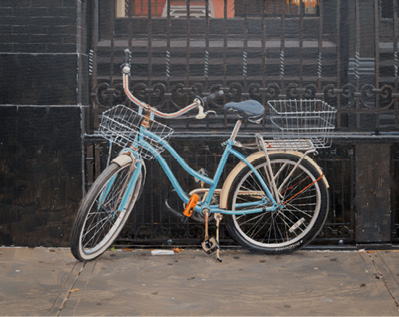
He had already done some freelance work as an illustrator while at school, and he had always been interested in comic books, film, and animation. He spent the next 16 to 17 years working on comic books, for all the major comics publishers, DC, Marvel, Dark Horse Comics, etc. He found it very fulfilling, to create a whole project. But at a certain point, the industry hit a slump, so he turned to other types of illustration. He worked for Viacom, Simon & Schuster, and other clients; he even worked on Rugrats, the animated television series. The money was good, but the work was not fulfilling. He wasn’t rendering and that was the thing he loved most. It was empty. This period was followed by some soul-searching. He turned to journal writing and he found it helped him to find what he wanted to do, which was to paint. What he learned: “Challenge yourself—push yourself outside of your own comfort zone and you will find new ground.”

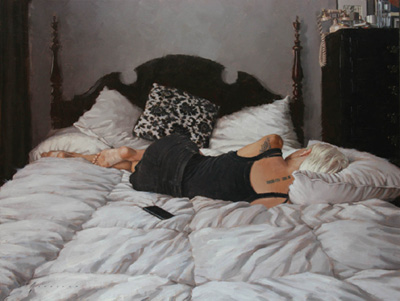
Vincent began taking life drawing classes at WAA’s studio (Washington Art Association) and got together with a bunch of artists, going out to paint together. They also sometimes rented a space and held 6-hour figure drawing sessions. “That was the thing I was looking for.” Fine art suddenly became a possibility. He tried going back to sculpture, realized that it was wrong for him. He discovered realism and John Singer Sargent. He loved the classical realism that was happening in the art worlds of New York and L.A. This art movement reflected a return to formal skills, to craft, and yet it was very contemporary. He decided that he wanted to do representational and meaningful work, not conceptual art like in school where art was clever, trendy, and fake. His work would be more real and substantial, sincere work that meant something to him, and that people could enjoy. He wanted his work to be true—to find truth. And to him, “life” is truthful.

In addition to the art classes, he taught himself through books, videos, a few short painting workshops and demos. He found that he was always learning, and he continues to be receptive to learning, “It is important in mainting creativity.” At around the age of 40, Vincent Giarrano found what he was looking for, what he was supposed to be doing—painting. And he’s been at it ever since, almost 16 years now.
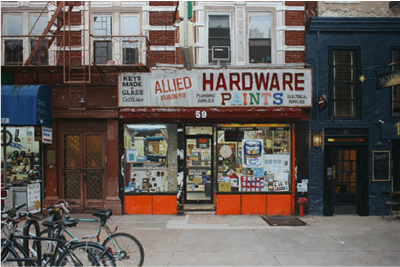
To make the transition from commercial art to fine art, Vincent put together a five-year plan. He continued doing his illustration work because he had a family to help support, and he began painting at the same time. After three solo shows in the area—at Marty’s Cafe, the Roxbury Library, and and a space in Woodbury—he was able to make a living from it. He dropped his commercial work and focused on painting.
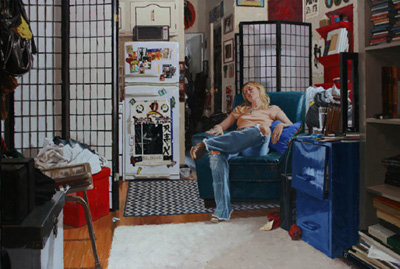
Today, Vincent still keeps journals. He writes about his concepts, people, technique, lists, even business aspects. He enjoys the business side. He is represented by seven to nine galleries at any given time, spread out around the U.S., England, and France. He has one big show a year, more or less. He likes to create a series of paintings for shows, but he only works on one painting at a time. In 2013-2014, he had a couple of paintings chosen for shows at museums. One painting, Aureta Thomollari at Fashion Week-NYC (shown here), was accepted at the BP Show at the National Portrait Gallery in London, and another painting, City Girl (also shown here) was accepted by the prestigious Outwin Boochever Competition into a show about redefining portraiture at The Smithsonian in Washington, DC. The artist says, “Every bit you do does a little bit of good—it always helps.”
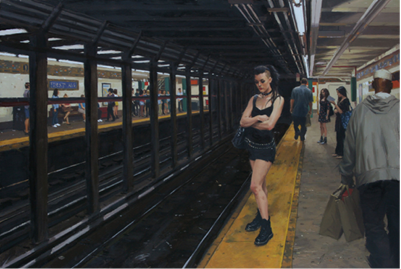
When asked about artists who have influenced him, Vincent says, “John Singer Sargent—he was a painter’s painter. His work was bold and expressive. Also, Swedish artist Anders Zorn, and Joaqim Sorolla.” American artist John Singer Sargent was the leading portrait painter of his generation. Anders Zorn was Sweden’s master portrait painter, but he was so well-known around the world, he even painted portraits of three American Presidents: Grover Cleveland, William H. Taft and Theodore Roosevelt. And Joaqim Sorolla was a Spanish painter, who excelled in the painting of portraits, landscapes, and monumental works of social and historical themes. “All three of these influential artists knew Isabella Stewart Gardner, the American art collector, philanthropist, and patron of the arts. All three artists had expressive brushstrokes and a high level of realism. They were important to me.”
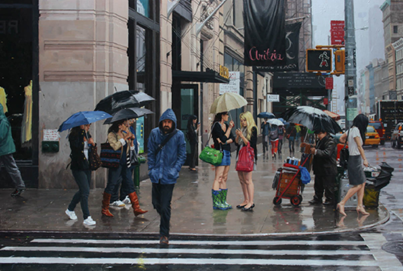
Back in Litchfield county, Vincent is involved in the local community. Rich with cultural events and natural beauty, the area turned out to be the perfect setting for Vincent’s life as an artist. He has taught classes, given painting sessions, and participated in local shows at WAA. He has some patrons of his work in the area. For years he has been going weekly to draw at WAA on Tuesday nights for 2 1/2 hours. “It’s multiple poses. I feel it’s the best exercise, keeps my “eye” sharp.”
Vincent Giarrano has mastered an impressive body of work in the years since he first started painting, yet he remains open to growth, new possibilities, and change. “The whole process is about change and loss.” So far, this openness to new things has served him well and we can look forward to more of his brilliance. For those of us who are fans of his work, Giarrano will have a one-man show in 2016, but it’s not scheduled yet, so we will have to be content with knowing that it’s coming.
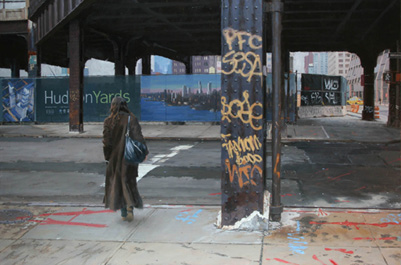
For more information on his work or to contact Vincent to purchase a painting, you may reach him at:
Vincent Giarrano (@vgiarrano) – Instagram photos and videos





